You have an Azure subscription that contains an Azure Time Series Insights environment. The environment has the properties shown in the following table.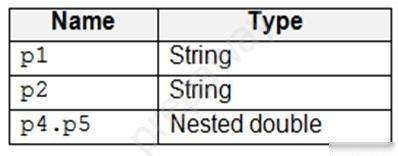
You need to create a D.
Which two time series expressions can be correctly used as part of the query? Each correct answer presents a complete solution.
NOTE: Each correct selection is worth one point.
AC
Example: $event['p1'] != NULL -
['p1'] is the only token used. Interpreted as $event['p1'].Double != NULL
Incorrect Answers:
B: $event.p1 = 'abc'
Type mismatch.
D: $event.p4.p5 = 0.0 -
Invalid property reference syntax. A type must be specified on LHS of comparison.
Reference:
https://docs.microsoft.com/en-us/rest/api/time-series-insights/reference-time-series-expression-syntax
You have an Azure subscription that contains an Azure IoT hub, 500 IoT devices, and an Azure Time Series Insights Gen2 environment named Environment1.
You need to add calculated values to the Time Series Model.
What should you use?
B
Time Series Model types help you define variables or formulas for doing computations. Types are associated with a specific instance.
A type can have one or more variables. For example, a Time Series Model instance might be of type Temperature Sensor, which consists of the variables avg temperature, min temperature, and max temperature.
Incorrect Answers:
A: Time Series Model instances are virtual representations of the time series themselves.
In most cases, instances are uniquely identified by deviceId or assetId, which are saved as time series IDs.
C: Time Series Model hierarchies organize instances by specifying property names and their relationships.
Reference:
https://docs.microsoft.com/en-us/azure/time-series-insights/concepts-model-overview
You have 10 IoT devices that connect to an Azure IoT hub named Hub1.
From Azure Cloud Shell, you run az iot hub monitor-events --hub-name Hub1 and receive the following error message: "az iot hub: 'monitor-events' is not in the 'az iot hub' command group. See 'az iot hub --help'."
You need to ensure that you can run the command successfully.
What should you run first?
D
Execute az extension add --name azure-cli-iot-ext once and try again.
In order to read the telemetry from your hub by CLI, you have to enable IoT Extension with the following commands:
Add: az extension add --name azure-cli-iot-ext
Reference:
https://github.com/MicrosoftDocs/azure-docs/issues/20843
You have an Azure Stream Analytics job that connects to an Azure IoT hub named Hub1445 as a streaming data source. Hub1445 is configured as shown in the exhibit.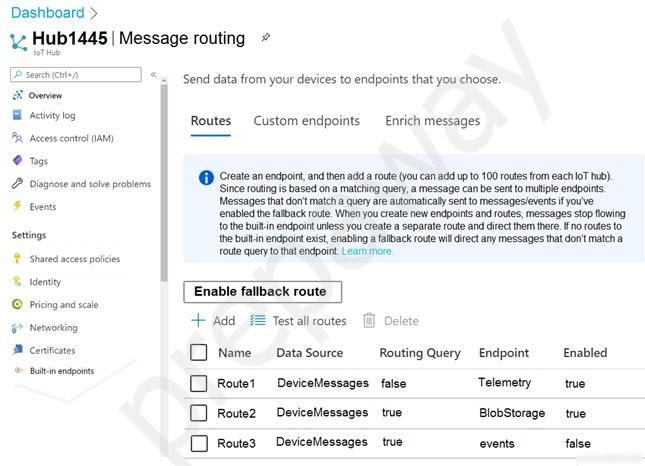
The Stream Analytics job fails to receive any messages from the IoT hub.
What should you do to resolve the issue?
B
Events are not getting through as Route3, with an events Endpoint, is not enabled.
Note: Azure IoT Hub is a highly scalable publish-subscribe event ingestor optimized for IoT scenarios.
The default timestamp of events coming from an IoT Hub in Stream Analytics is the timestamp that the event arrived in the IoT Hub, which is
EventEnqueuedUtcTime.
Reference:
https://www.darenmay.com/office365/2019/01/27/azure-iot-streaming-analytics-data-lake-analytics-and-json.html
You plan to deploy a standard tier Azure IoT hub.
You need to perform an over-the-air (OTA) update on devices that will connect to the IoT hub by using scheduled jobs.
What should you use?
D
Releases via the REST API.
All of the operations that can be performed from the Console can also be automated using the REST API. You might do this to automate your build and release process, for example.
You can build firmware using the Particle CLI or directly using the compile source code API.
Note: Over-the-air (OTA) firmware updates are a vital component of any IoT system. Over-the-air firmware updates refers to the practice of remotely updating the code on an embedded device.
Reference:
https://docs.particle.io/tutorials/device-cloud/ota-updates/
You have an IoT device that gathers data in a CSV file named Sensors.csv.
You deploy an Azure IoT hub that is accessible at ContosoHub.azure-devices.net.
You need to ensure that Sensors.csv is uploaded to the IoT hub.
Which two actions should you perform? Each correct answer presents part of the solution.
NOTE: Each correct selection is worth one point.
AC
C: To use the file upload functionality in IoT Hub, you must first associate an Azure Storage account with your hub. Select File upload to display a list of file upload properties for the IoT hub that is being modified.
For Storage container: Use the Azure portal to select a blob container in an Azure Storage account in your current Azure subscription to associate with your IoT
Hub. If necessary, you can create an Azure Storage account on the Storage accounts blade and blob container on the Containers
A: IoT Hub has an endpoint specifically for devices to request a SAS URI for storage to upload a file. To start the file upload process, the device sends a POST request to {iot hub}.azure-devices.net/devices/{deviceId}/files with the following JSON body:
{
"blobName": "{name of the file for which a SAS URI will be generated}"
}
Incorrect Answers:
D: Deprecated: initialize a file upload with a GET. Use the POST method instead.
Reference:
https://github.com/MicrosoftDocs/azure-docs/blob/master/articles/iot-hub/iot-hub-configure-file-upload.md
You plan to deploy an Azure IoT hub.
The IoT hub must support the following:
✑ Three Azure IoT Edge devices
✑ 2,500 IoT devices
Each IoT device will spend a 6 KB message every five seconds.
You need to size the IoT hub to support the devices. The solution must minimize costs.
What should you choose?
D
2500* 6 KB * 12 = 180,000 KB/minute = 180 MB/Minute.
B3, S3 can handle up to 814 MB/minute per unit.
Incorrect Answers:
A, C: B1, S1 can only handle up to 1111 KB/minute per unit
B: B2, S2 can only handle up to 16 MB/minute per unit.
Reference:
https://docs.microsoft.com/en-us/azure/iot-hub/iot-hub-scaling
DRAG DROP -
You deploy an Azure IoT hub.
You need to demonstrate that the IoT hub can receive messages from a device.
Which three actions should you perform in sequence? To answer, move the appropriate actions from the list of actions to the answer area and arrange them in the correct order.
Select and Place:

Step 1: Register a device in IoT Hub
Before you can use your IoT devices with Azure IoT Edge, you must register them with your IoT hub. Once a device is registered, you can retrieve a connection string to set up your device for IoT Edge workloads.
Step 2: Configure the device connection string on a device client.
When you're ready to set up your device, you need the connection string that links your physical device with its identity in the IoT hub.
Step 3: Trigger a new send event from a device client.
Reference:
https://docs.microsoft.com/en-us/azure/iot-edge/how-to-register-device
You are troubleshooting an Azure IoT hub.
You discover that some telemetry messages are dropped before they reach downstream processing.
You suspect that IoT Hub throttling is the root cause.
Which log in the Diagnostics settings of the IoT hub should you use to capture the throttling error events?
B
The device telemetry category tracks errors that occur at the IoT hub and are related to the telemetry pipeline. This category includes errors that occur when sending telemetry events (such as throttling) and receiving telemetry events (such as unauthorized reader). This category cannot catch errors caused by code running on the device itself.
Note: The metric d2c.telemetry.ingress.sendThrottle is the number of throttling errors due to device throughput throttles.
Reference:
https://docs.microsoft.com/en-us/azure/iot-hub/iot-hub-monitor-resource-health
You have 20 devices that connect to an Azure IoT hub.
You open Azure Monitor as shown in the exhibit.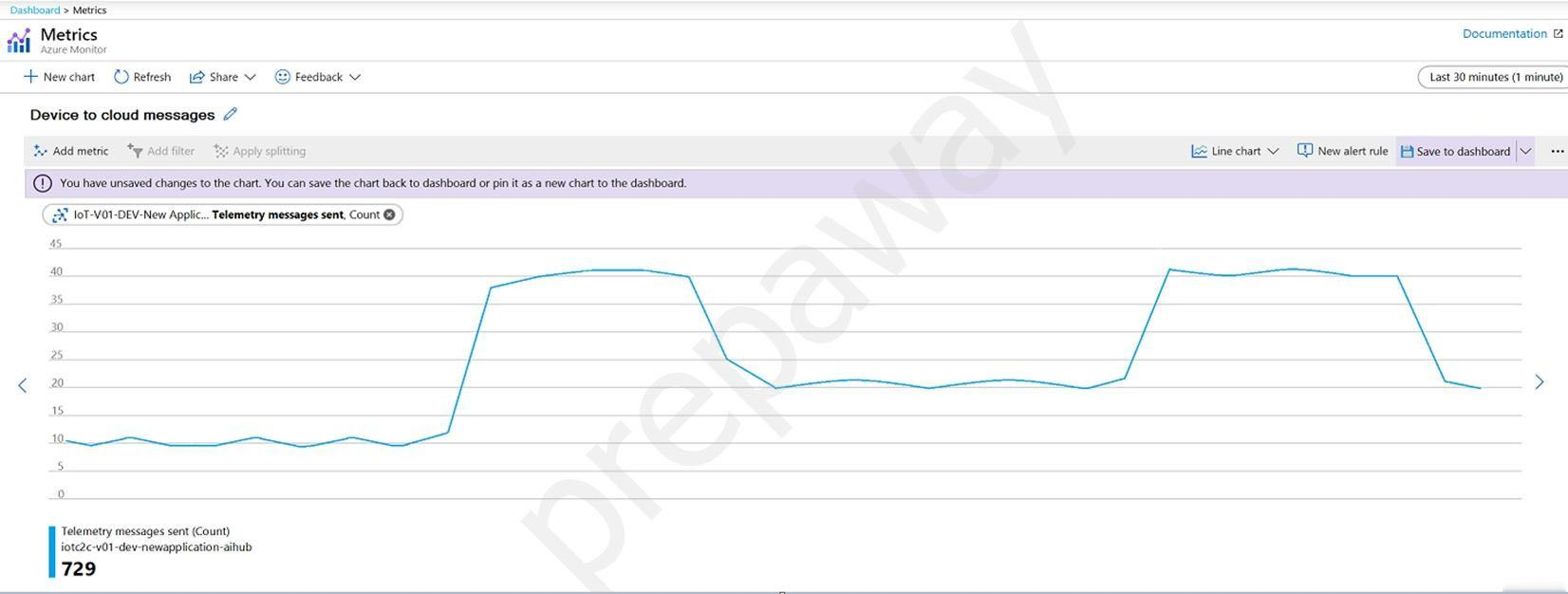
You discover that telemetry is not being received from five IoT devices.
You need to identify the names of the devices that are not generating telemetry and visualize the data.
What should you do first?
D
To log device connection events and errors, turn on diagnostics for IoT Hub. We recommend turning on these logs as early as possible, because if diagnostic logs aren't enabled, when device disconnects occur, you won't have any information to troubleshoot the problem with.
1. Sign in to the Azure portal.
2. Browse to your IoT hub.
3. Select Diagnostics settings.
4. Select Turn on diagnostics.
5. Enable Connections logs to be collected.
6. For easier analysis, turn on Send to Log Analytics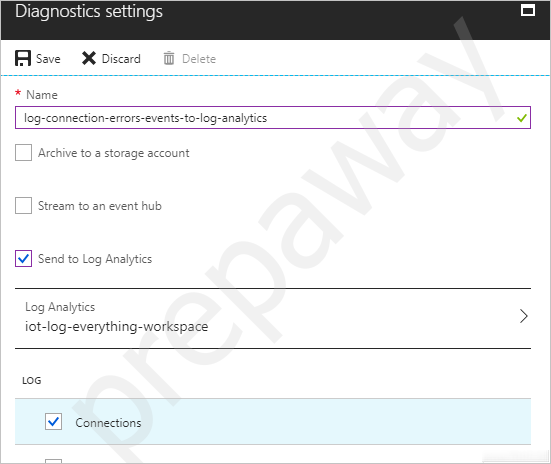
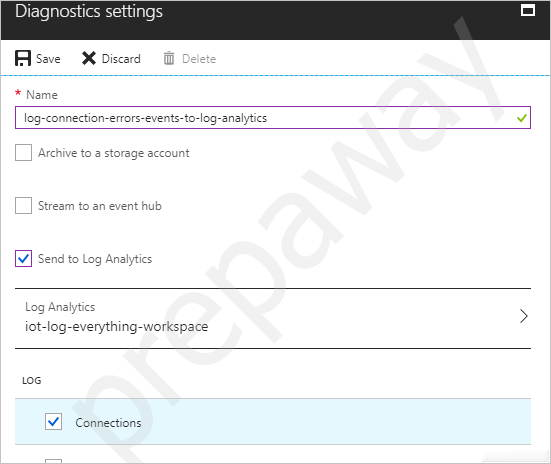
Reference:
https://docs.microsoft.com/bs-cyrl-ba/azure/Iot-hub/iot-hub-troubleshoot-connectivity